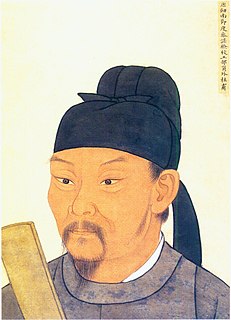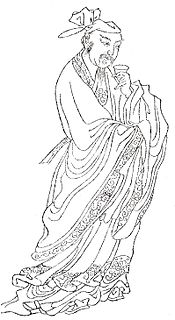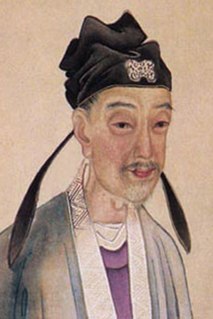Related Research Articles

Li Bai, also known as Li Bo, courtesy name Taibai, art name Qinglian Jushi, was a Chinese poet, acclaimed from his own time to the present as a brilliant and romantic figure who took traditional poetic forms to new heights. He and his friend Du Fu (712–770) were two of the most prominent figures in the flourishing of Chinese poetry in the Tang dynasty, which is often called the "Golden Age of Chinese Poetry". The expression "Three Wonders" denotes Li Bai's poetry, Pei Min's swordplay, and Zhang Xu's calligraphy.

Chinese poetry is poetry written, spoken, or chanted in the Chinese language. While this last term comprises Classical Chinese, Standard Chinese, Mandarin Chinese, Yue Chinese, and other historical and vernacular forms of the language, its poetry generally falls into one of two primary types, Classical Chinese poetry and Modern Chinese poetry.

Classical Chinese poetry is traditional Chinese poetry written in Classical Chinese and typified by certain traditional forms, or modes; traditional genres; and connections with particular historical periods, such as the poetry of the Tang Dynasty. The existence of classical Chinese poetry is documented at least as early as the publication of the Classic of Poetry (Shijing). Various combinations of forms and genres have developed over the ages. Many or most of these poetic forms were developed by the end of the Tang Dynasty, in 907 CE.

Du Fu was a Chinese poet and politician of the Tang dynasty. Along with his elder contemporary and friend Li Bai, he is frequently called the greatest of the Chinese poets. His greatest ambition was to serve his country as a successful civil servant, but he proved unable to make the necessary accommodations. His life, like the whole country, was devastated by the An Lushan Rebellion of 755, and his last 15 years were a time of almost constant unrest.

Du Mu (Chinese: 杜牧; pinyin: Dù Mù; Wade–Giles: Tu4 Mu4; 803–852) was a Chinese calligrapher, poet, and politician who lived during the late Tang dynasty. His courtesy name was Muzhi (牧之), and sobriquet Fanchuan (樊川). He is best known for his lyrical and romantic quatrains.

Bai Juyi, courtesy name Letian, was a renowned Chinese poet and Tang dynasty government official. Many of his poems concern his career or observations made about everyday life, including as governor of three different provinces. He achieved fame as a writer of verse in a low-key, near vernacular style that was popular throughout China, in Korea and Japan.

Meng Haoran was a major Tang dynasty poet, and a somewhat older contemporary of Wang Wei, Li Bai and Du Fu. Despite his brief pursuit of an official career, Meng Haoran mainly lived in and wrote about the area in which he was born and raised, in what is now Hubei province, China. Meng Haoran was a major influence on other contemporary and subsequent poets of the High Tang era because of his focus on nature as a main topic for poetry. Meng Haoran was also prominently featured in the Qing dynasty poetry anthology Three Hundred Tang Poems, having the fifth largest number of his poems included, for a total of fifteen, exceeded only by Du Fu, Li Bai, Wang Wei, and Li Shangyin. These poems of Meng Haoran were available in the English translations by Witter Bynner and Kiang Kanghu, by 1920, with the publication of The Jade Mountain. The Three Hundred Tang Poems also has two poems by Li Bai addressed to Meng Haoran, one in his praise and one written in farewell on the occasion of their parting company. Meng Haoran was also influential to Japanese poetry.

Li Shangyin, courtesy name Yishan, was a Chinese poet and politician of the late Tang dynasty, born in the Henei Commandery. He is noted for the imagist quality of his poems and his "no title" style of poetry. Li Shangyin has been frequently anthologized, and many of his poems have been translated into various languages, including several collections in English.
Yuefu are Chinese poems composed in a folk song style. The term originally literally meant "Music Bureau", a reference to the imperial Chinese governmental organization(s) originally charged with collecting or writing the lyrics, later the term yuefu was applied to later literary imitations or adaptations of the Music Bureau's poems. The use of fu in yuefu is different from the other Chinese term fu that refers to a type of poetry or literature: although homonyms in English, the other fu is a rhapsodic poetry/prose form of literature.
Three Chinese Poets is a book of poetry by the titular poets Wang Wei, Li Bai and Du Fu translated into English by Vikram Seth. The Three Poets were contemporaries and are considered to be amongst the greatest Chinese poets by many later scholars. The three have been described as a Buddhist recluse, a Taoist immortal and a Confucian sage respectively. Though this trichotomy has been criticised as simplistic and artificial, it can act as a guiding approximation. They lived in the Tang Dynasty and the political strife at that time affected all of their lives very much and this impact is evident in the poetry of all three.

Keith James Holyoak is a Canadian-American researcher in cognitive psychology and cognitive science, working on human thinking and reasoning. Holyoak's work focuses on the role of analogy in thinking. His work showed how analogy can be used to enhance learning of new abstract concepts by both children and adults, as well as how reasoning breaks down in cases of brain damage.

Chen Zi'ang, courtesy name Boyu (伯玉), was a Chinese poet of the Tang dynasty. He was important in helping to bring into being the type of poetry which is considered to be characteristically "Tang". Dissatisfied with the current state of the affairs of poetry at the time, almost paradoxically, by keeping his eye on the remote antiquity he helped usher in a new age of Chinese poetry. He would soon be followed by such poets of the golden age of Tang poetry as Wang Wei, Li Bai, and Du Fu.
The Three Hundred Tang Poems is an anthology of poems from the Chinese Tang dynasty (618–907). It was first compiled around 1763 by Sun Zhu (1722–1778), who was a Qing Dynasty scholar and was also known as Hengtang Tuishi. Various later editions also exist. All editions contain slightly more than 300 total poems. The number 300 was a classic number for a poetry collection due to the influence of the Classic of Poetry, which was generally known as The Three Hundred Poems.

The arts of China have varied throughout its ancient history, divided into periods by the ruling dynasties of China and changing technology, but still containing a high degree of continuity. Different forms of art have been influenced by great philosophers, teachers, religious figures and even political leaders. The arrival of Buddhism and modern Western influence produced especially large changes. Chinese art encompasses fine arts, folk arts and performance arts.
Tang poetry refers to poetry written in or around the time of or in the characteristic style of China's Tang dynasty, and/or follows a certain style, often considered as the Golden Age of Chinese poetry. The Quantangshi includes over 48,900 poems written by over 2,200 authors. During the Tang dynasty, poetry continued to be an important part of social life at all levels of society. Scholars were required to master poetry for the civil service exams, but the art was theoretically available to everyone. This led to a large record of poetry and poets, a partial record of which survives today. The two most famous poets of the period were Li Bai and Du Fu. Through the Three Hundred Tang Poems, Tang poetry has remain familiar to educated Chinese in modern times.
Sun Zhu (1711–1778) was a Qing scholar. He was also known as Hengtang Tuishi and was the original compiler and editor of the anthology Three Hundred Tang Poems, a popular compilation of Tang poetry, partly designed as a study aid for students. An enduring classic, Sun Zhu's version has often been reprinted, often in revised or re-edited editions.
Sunflower Splendor: Three Thousand Years of Chinese Poetry is an anthology of around 1,000 Chinese poems translated into English, edited by Wu-chi Liu and Irving Yucheng Lo and published in 1975 by Anchor Press/Doubleday. Wu-chi Liu served as the anthology's senior editor. As of 2002 the book had been widely used in Asian literature studies. In 2002 Stacy Finz of the San Francisco Chronicle wrote that the book "was a best-seller".

Simians of various sorts are an important motif in Chinese poetry. Examples of simian imagery have an important place in Chinese poetry ranging from the Chu Ci poets through poets such as Li Bai, Wang Wei, Du Fu, and more. Various poetic concepts could be communicated by the inclusion of simian imagery in a poem, and the use of simian allusions can help provide key insights into the poems. The use of simians in Chinese poetry is part of a broader appearance of macaques and other monkeys in Chinese culture as well as the monkey-like gibbons and sometimes monkey-like creatures from Chinese mythology.
References
- ↑ Holyoak, K. (translator) (2007). Facing the Moon: Selected Poems of Li Bai and Du Fu. Durham, NH: Oyster River Press. ISBN 978-1-882291-04-5.
- ↑ http://www.off-the-coast.com/rev15.4.2.html